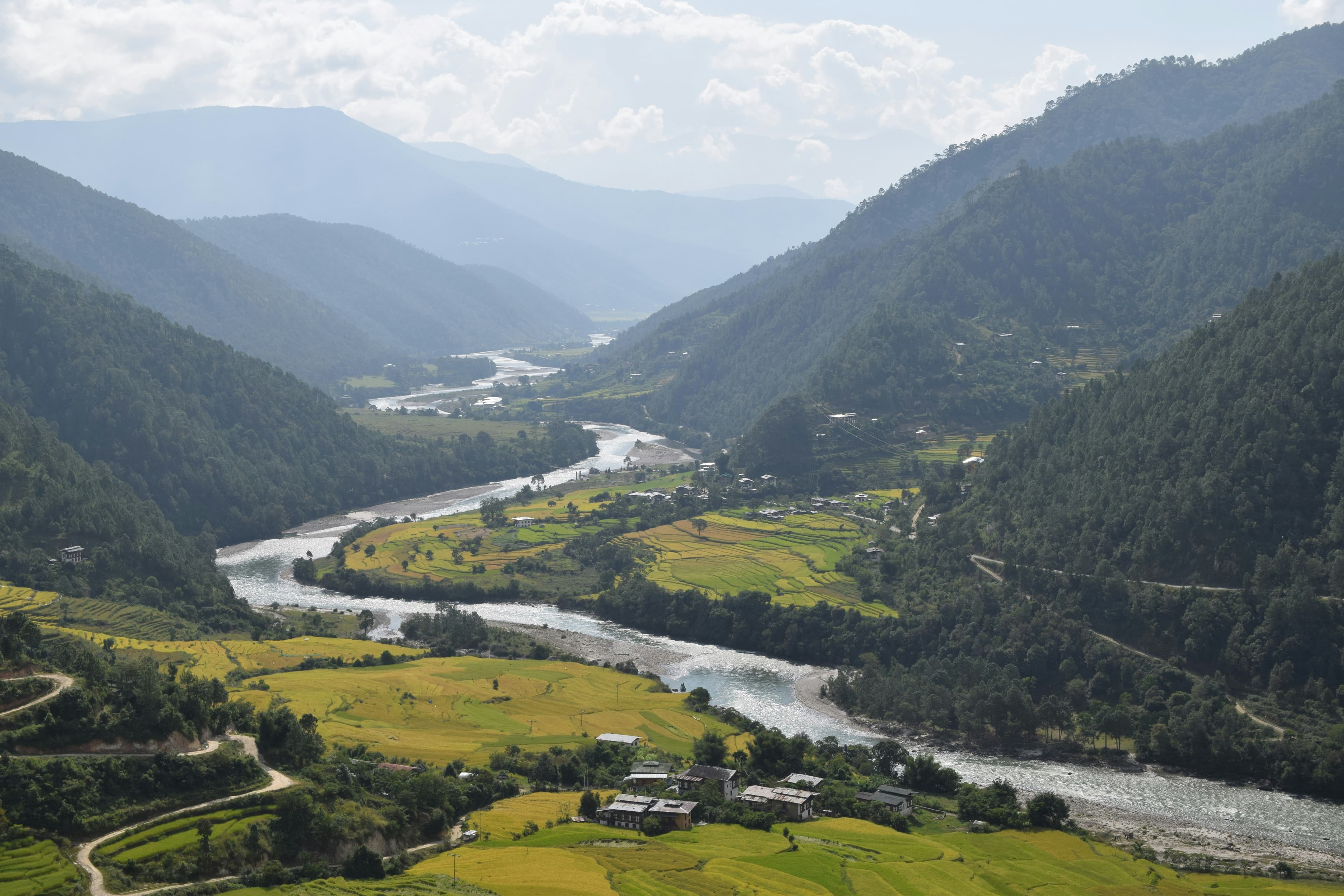
Phobjikha Valley, often called the “Valley of the Black-necked Cranes,” is a serene glacial valley in Bhutan known for its breathtaking landscapes, rich biodiversity, and deep cultural heritage. Surrounded by rolling meadows and dense forests, it serves as a sanctuary for rare wildlife, including the endangered black-necked cranes. The valley offers a tranquil retreat where nature and ancient Buddhist traditions coexist harmoniously, providing visitors with a unique and soulful experience.
Tucked away in the pristine wilderness of Bhutan, Phobjikha Valley is a hidden gem where nature and tradition exist in perfect harmony. This glacial valley, surrounded by rolling meadows and dense forests, is a sanctuary for rare wildlife and a place of deep spiritual significance. Known as the “Valley of the Black-necked Cranes,” it offers visitors a tranquil retreat, where the rhythms of nature dictate life’s pace and ancient Buddhist culture thrives untouched by time. Whether you seek breathtaking landscapes, rare wildlife encounters, or a glimpse into Bhutan’s soulful traditions, Phobjikha promises an experience unlike any other.
A Valley of Natural Beauty
Phobjikha is a wide, U-shaped valley situated on the western slopes of the Black Mountains, at an altitude of about 3,000 meters (9,800 feet) above sea level. Unlike other valleys in Bhutan, Phobjikha has no urban sprawl—only vast meadows, quaint villages, and dense pine forests. The valley remains untouched by modern infrastructure, allowing visitors to experience Bhutan’s unspoiled beauty.
The cool mountain air, rolling green hills, and slow-paced life make Phobjikha an ideal retreat for travelers seeking tranquility. With no noisy traffic or high-rise buildings, the valley offers a sense of peace that is hard to find elsewhere.
One of the most remarkable aspects of Phobjikha is its status as the winter home of the endangered Black-necked Cranes (Grus nigricollis). These majestic birds migrate from Tibet to Phobjikha every winter, arriving in late October and leaving by mid-March. The cranes hold a special place in Bhutanese culture and spirituality, symbolizing longevity, peace, and harmony.
The Gangtey Goenpa Monastery, which overlooks the valley, is said to bless the cranes as they circle the monastery three times upon arrival and departure. This mesmerizing sight attracts birdwatchers, photographers, and nature lovers from around the world.
To celebrate these sacred birds, Bhutan hosts the Black-necked Crane Festival every year on November 11 at the Gangtey Monastery. The festival includes traditional mask dances, songs, and educational programs dedicated to crane conservation.
At the center of Phobjikha Valley stands the Gangtey Goenpa Monastery, a revered Buddhist monastery belonging to the Nyingma school of Tibetan Buddhism. Built in the 17th century, the monastery is not only an architectural marvel but also a place of deep spiritual significance. Monks residing here follow strict monastic practices, and the monastery serves as an important pilgrimage site for Bhutanese Buddhists.
Visitors can explore the monastery’s intricate murals, ancient relics, and prayer halls while soaking in panoramic views of the valley. The monastery is also a gateway to various nature trails that lead to breathtaking viewpoints.
For those who love adventure, Phobjikha offers some of the best hiking trails in Bhutan. The Gangtey Nature Trail is a popular short trek that takes visitors through forests, quaint villages, and open meadows. This easy yet rewarding hike offers stunning views of the valley and an opportunity to experience the daily life of the local people.
Longer treks, such as the Gangtey Trek, allow hikers to explore the remote wilderness, passing through alpine landscapes, ancient monasteries, and yak herder camps. These treks offer a deep connection with nature and Bhutan’s untouched landscapes.
Bhutan follows a strict "High-Value, Low-Impact" tourism policy, and Phobjikha Valley is a prime example of this approach. The valley is a protected conservation area, and local communities actively participate in sustainable tourism efforts.
Eco-lodges, traditional homestays, and guesthouses provide comfortable accommodations while minimizing environmental impact. Visitors are encouraged to follow responsible tourism practices, such as minimizing waste and respecting local customs.
Phobjikha is home to warm and welcoming locals, mostly from the Sharchop and Ngalop ethnic groups. Their lifestyle revolves around agriculture, with potato farming being a major source of livelihood. Visitors can experience authentic Bhutanese hospitality by staying in traditional farmhouses, enjoying home-cooked meals, and engaging in cultural exchanges.
Some must-try local dishes include:
Ema Datshi – Bhutan’s signature dish of chilies and cheese.
Red Rice – A staple food grown in Bhutan’s high-altitude fields.
Momos – Traditional dumplings filled with cheese, vegetables, or meat.
Suja (Butter Tea) – A unique Bhutanese drink made from butter and salt.
The best time to visit Phobjikha Valley depends on what you want to experience:
Winter (November – March): Ideal for witnessing the Black-necked Cranes and experiencing the valley’s serene beauty.
Spring (March – May): The valley blooms with rhododendrons and wildflowers, making it a paradise for nature lovers.
Autumn (September – November): Offers clear skies, pleasant weather, and the vibrant Black-necked Crane Festival.
Phobjikha Valley is more than just a picturesque travel destination—it is a place where nature, spirituality, and culture coexist in perfect harmony. Whether you seek peace in its monasteries, adventure in its trails, or a glimpse of the rare Black-necked Cranes, Phobjikha offers an unforgettable experience.
In a world that is rapidly changing, Phobjikha remains a sanctuary of timeless beauty and tranquility. If you are looking for a place where the air is fresh, the landscapes untouched, and the people warm, Phobjikha Valley is calling you.